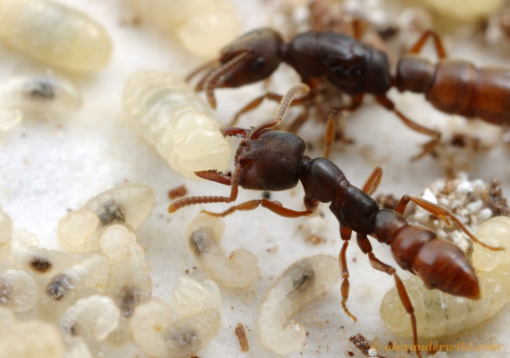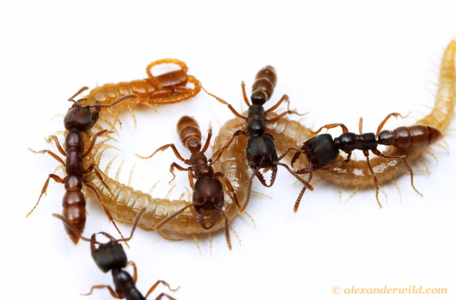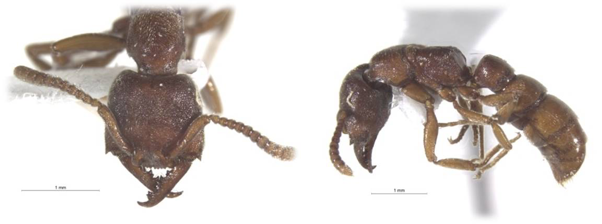Nature Nugget – Feb. 21, 2019
By Staffan Lindgren
Of all the insects in the world, the ants are some of the most successful (Guénard 2013). To date, about 13,000 species have been described. By insect standards, that is a fairly modest number. However, ants are eusocial insects, meaning that they live in societies with cooperative brood care, overlapping generations, and division of labour with reproductive and non-reproductive groups. In terms of biomass, ants are estimated to make up a huge proportion of the biomass of animals on the planet. Regardless, for most people, ants tend to be at best annoying, and at worst serious pests. Examples of the latter are the tiny and very common odorous house ant, carpenter ants, and fire ants.
Ants evolved from wasps, and like a majority of bees they have a haplodiploid sex determination system. That means that males develop from unfertilized eggs, and females from fertilized eggs. Among the eusocial ants, all of the ones we see slaving away are non-reproductive female workers. Males are only present as alate (winged) individuals at swarming with the sole purpose of mating, after which they die. Females of species in several subfamilies have ovipositors modified into stingers connected to venom glands, just like wasps, whereas the ants in some other subfamilies, including our most commonly seen species in BC, have lost the stinger. Depending on the species, nests can house one or many reproductive females (queens).

All ants do not live up to the hard working image we all have of them, however. There are slave-making ants and even parasitic ants (Buschinger 2009). One really odd group is the so-called Dracula ants. Not surprisingly, the habits of these curious ants inspire hyperbolic headlines like: “Shadow, Labyrinth, Mirror: New Species of Child-Eating Dracula Ants Get Cool Ninja Names”, “Blood-sucking dracula ant sets the new record for fastest animal”, and “Dracula ant’s killer jaws are nature’s fastest mover at 200mph”.
Most ants can share food by tropholaxis, but Dracula ants are unable to do this. Instead they have a curious habit of feeding on the haemolymph of their larvae, which is how they got their collective name. In some species, they acquire the haemolymph by puncturing the ‘skin’ of the larvae, whereas in others, larvae possess specialized ‘haemolymph tap structures’ (Masuko 1986, Masuko 2019). Most Dracula ants are found in the tropics, and belong to the subfamily Amblyoponinae, but there are species scattered among other subfamilies as well.

Why is this of interest to us? Well, it turns out that we have one species of Dracula ant living right here on Vancouver Island! Stigmatomma (Amblyopone) oregonense is a medium-sized ant found in small scattered colonies nesting in rotten wood, under bark, rocks or in similar places in mixed conifer forests (Ward 1988). New colonies are founded by newly mated queens after swarming and mating in the summer. Because of its small colonies and cryptic habits, it is rarely found, and only a few BC records are known. Like many Dracula ants, it is a specialized predator on soil centipedes (Geophilomorpha), supplemented by some other arthropods. Workers, attack these, kill them by stinging, and carry them back to the nest. They are cut up and/or masticated by the workers, which feed on any haemolymph oozing from them, after which larvae are placed on the prey to feed. The queen feeds exclusively by larval haemolymph feeding, and workers also engage in this behaviour when required. Larvae are scarred by this behaviour but appear to suffer no other ill effects.

This is yet another fascinating example of how evolution leads to odd solutions. In the insect world, you will find that pretty much anything goes. You can hear more about these ants in this Quirks and Quarks podcast with my former PhD student Rob Higgins, Associate Professor, TRU, Kamloops. https://www.cbc.ca/player/play/2354751420
If you come across this species, please contact me at Nature Nanaimo.
References
Buschinger, A. 2009. Social parasitism among ants: a review (Hymenoptera: Formicidae). Myrmecological News. 12: 219-235.
Guénard, B. 2013. An overview of the species and ecological diversity of ants. In: eLS. John Wiley & Sons, Ltd: Chichester. DOI: 10.1002/9780470015902.a0023598
Masuko, K. 1986. Larval hemolymph feeding: a nondestructive parental cannibalism in the primitive ant Amblyopone silvestrii Wheeler (Hymenoptera: Formicidae). Behavioral Ecology and Sociobiology 19: 249.
Masuko, K. 2019. Larval hemolymph feeding and hemolymph taps in the ant Proceratium itoi (Hymenoptera: Formicidae). Myrmecological News. 29: 21-34.
Ward, P.S. 1988. Mesic elements in the western Nearctic ant fauna: taxonomic and biological notes on Amblyopone, Proceratium, and Smithistruma (Hymenoptera: Formicidae). Journal of the Kansas Entomological Society. 61: 102-124.
